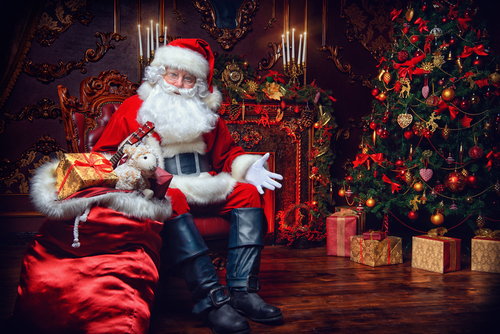
A brief history of Santa Claus

Image credit: Kiselev Andrey Valerevich/Shutterstock.com
The Origin of Saint Nicholas
Saint Nicholas, otherwise known as Santa Claus, has long been steeped in the traditions of Christmas. He is considered to be a jolly fat man with a white beard, who dresses all in red, who brings presents to children on Christmas Eve. However, the story of Saint Nicholas stretches all the way back to the 3rd century and originates in what is now modern-day Turkey.
It is believed that Nicholas was born sometime around 280 AD in Patara, near Myra in modern-day Turkey. Much admired for his godliness and kindness, St. Nicholas became the instigation behind much legend and folklore. It is said that he gave away all of his inherited wealth and travelled the countryside helping the poor and sick. One of the best-known stories about St. Nicholas is that he once saved three poor sisters. They were due to be sold into slavery or prostitution by their father but Nicholas provided them with a dowry so that they could marry.
A Virtuous Saint Nicholas
Over the years, Nicholas’s virtuous reputation spread far and wide. He particularly became known as the guardian of children and sailors. The Feast of Saint Nicholas or Saint Nicholas’s Day is celebrated on the anniversary of his death on 6 December. Although, the day is recognised on 19 December by the Eastern Orthodox Church.
Soon St. Nicholas’s Day began to be considered a lucky day. It became traditional for people to make a large purchase or get married on the day. By the Renaissance period, St. Nicholas had become the most popular saint in Europe. After the Reformation, the veneration of saints was discouraged by the Protestant Church. However, St Nicholas was still held in high regard, especially in Holland.
St. Nicholas first entered American popular culture towards the end of the 18th century. In December 1773, a New York newspaper reported that groups of Dutch families had gathered to honour the anniversary of St. Nicholas’s death. This sparked national interest in the Dutch holy man.
Sint Nikolaas
The name Santa Claus was derived from St. Nicholas’s Dutch nickname. Sinter Klaas, a shortened form of Sint Nikolaas, is the Dutch form of Saint Nicholas. In 1804, John Pintard, a member of the New York Historical Society, distributed woodcut images of St. Nicholas at the society’s annual meeting. The background of the engraving depicted now-familiar Christmas scenes, including stockings filled with toys.
In 1809, Washington Irving helped to popularise the Sinter Klaas stories. He referred to St. Nicholas as the patron saint of New York in his book; ‘The History of New York’. By this time, Sinter Klaas was being described as a bit of a rascal. It was said he dressed in a blue three-cornered hat, red waistcoat, and yellow stockings.
A Christmas Poem
In 1822, Clement Clarke Moore, a minister, wrote a Christmas poem for his three daughters entitled ‘An Account of a Visit from St. Nicholas,’. It soon became popularly known as “Twas The Night Before Christmas.” Moore’s poem helped to cement the modern image of Santa Claus as a portly, jolly figure with supernatural abilities.
Moore took his inspiration from the existing stories of St Nicholas, Odin and Father Christmas, but his poem helped popularise the image of a Santa Claus who flew from house to house on Christmas Eve on a sleigh pulled by eight flying reindeer to leave presents for deserving children. We also got the idea that Santa lives at the North Pole, has a list of good and bad children and receives letters from them about their Christmas present wishes.
An Image of Santa
On January 1st 1881, the influential magazine Harper’s Weekly published the first, now traditional, image of Santa, by satirist and illustrator John Nast. Drawing heavily on Moore’s depiction, it was Nast who first portrayed Santa Claus as a rotund, cheerful man with a full, white beard, a bright red suit trimmed with white fur, whilst holding a sack full of children’s toys. This image of Santa became popular, and artists from then on tended to very much use the Nash depiction of Santa Claus. When Coke Cola adopted this image of Santa wearing a ‘red’ costume for their adverts of the 1920s and 1930s, it set the future depiction forever.
By the mid 20th century, although from completely different beginnings, Santa Claus and his opposite number across the pond; Father Christmas, were beginning to look more and more alike. Such Santa’s influence on Father Christmas during this time that within in a few years they had more or less morphed into a single entity.
Header image credit: Kiselev Andrey Valerevich/Shutterstock.com
If you thought Santa Claus was just another name for Father Christmas why not check out our post by clicking here.
If you’ve enjoyed reading this post, why not check out more of the articles in the series by clicking the following link: Why do we…….?





